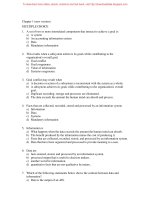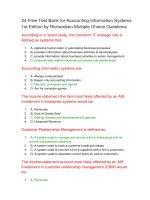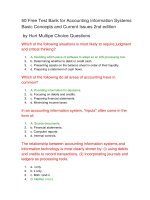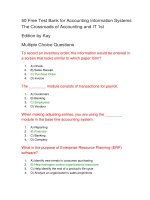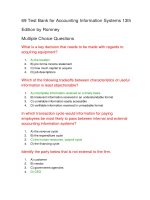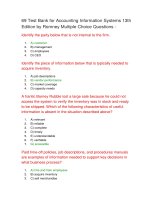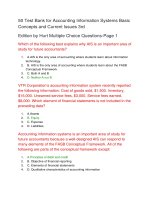34 free test bank for college accounting 14th edition
Bạn đang xem bản rút gọn của tài liệu. Xem và tải ngay bản đầy đủ của tài liệu tại đây (26.1 KB, 8 trang )
34 Free Test Bank for College Accounting 14th Edition
by Price Multiple Choice Questions
Identify the advantages of forming a business as an S
Corporation.
1.
A. owners avoid double taxation and owners have limited liability
2.
B. treated as a separate legal entity and owners avoid double taxation
3.
C. owners have limited liability and corporation's earnings are tax free
4.
D. owner is personally responsible for debts of the business and earnings
are reported
5.
directly on owner's personal tax return
Tax planning includes
1.
A. preparing tax returns.
2.
B. auditing tax returns.
3.
C. correcting tax returns.
4.
D. suggesting actions to reduce tax liability.
Identify which of the following are considered OUTSIDE users of
financial accounting information.
1.
A. employees
2.
B. managers
3.
C. owners
4.
D. banks
The area of accounting that involves the preparation of internal
reports for a firm's executives and the analysis of the data in
these reports to aid in decision making is known as
1.
A. financial accounting.
2.
B. managerial accounting.
3.
C. auditing.
4.
D. cost accounting.
The Financial Accounting Standards Board has the authority to
develop generally accepted accounting principles. Choose the
option below that contains the steps used by the FASB in
developing GAAP.
1.
A. steps include: publishing a notice in the newspaper, seeking public
opinion, and issuing a statement of principle.
2.
B. steps include: issuing a discussion memorandum, filing a legal draft, and
notifying the SEC.
3.
C. steps include: filing a complaint with the SEC, issuing an internal report,
and issuing a statement of principle.
4.
D. steps include: issuing a discussion memorandum, issuing an exposure
draft, and issuing a statement of principle.
The form of a business organization that is not affected by the
withdrawal or death of an owner and can continue forever is
1.
A. the sole proprietorship.
2.
B. the partnership.
3.
C. the corporation.
4.
D. the nonprofit organization.
Owners and managers need financial information in order to
1.
A. grant loans.
2.
B. issue credit.
3.
C. collect taxes.
4.
D. make decisions.
Which of the following is a true statement in regards to the
International Accounting Standards Board?
1.
A. The IASB deals with issues caused by the lack of uniform accounting
principles existing in different countries
2.
B. The IASB was created by the American Accounting Association
3.
C. The IASB develops all accounting principles to be used in the United
States
4.
D. The IASB has the authority to audit financial statements of all US
corporations
The government agency that has final authority over the financial
reporting of publicly owned corporations is
1.
A. the Securities and Exchange Commission.
2.
B. the Federal Trade Commission.
3.
C. the Internal Revenue Service.
4.
D. the Financial Accounting Standards Board.
Managerial accounting is
1.
A. public accounting.
2.
B. government accounting.
3.
C. private accounting.
4.
D. tax accounting.
An example of an economic entity is
1.
A. a town.
2.
B. a business.
3.
C. a politician.
4.
D. a church.
Which of the following is NOT a type of information communicated
by the financial statements?
1.
A. the equity, or value, of the business
2.
B. the amount spent on costs (expenses) of the business
3.
C. the types of products and services the business provides
4.
D. the amount of revenue earned by the business
Identify the form of business that is considered a separate legal
entity.
1.
A. a sole proprietorship
2.
B. a corporation
3.
C. a limited liability partnership
4.
D. a partnership
The review of financial statements to assess their fairness and
adherence to GAAP is
1.
A. accounting.
2.
B. preparation.
3.
C. compliance.
4.
D. auditing.
Identify the statement below that represents what GAAP stands
for
1.
A. Generally Accepted Accounting Principles.
2.
B. Generally Accepted Auditing Practices.
3.
C. General Accounting Actuary Principles.
4.
D. Generally Approved Accounting Practices.
The Financial Accounting Standards Board is responsible for
1.
A. auditing financial statements.
2.
B. developing generally accepted accounting principles.
3.
C. establishing accounting systems for businesses.
4.
D. making recommendations to the Securities and Exchange Commission.
Which of the following is NOT a service of public accounting
firms?
1.
A. auditing
2.
B. tax accounting
3.
C. management advisory services
4.
D. investment services
A form of the partnerships business entity is
1.
A. LLP.
2.
B. LLC.
3.
C. INP.
4.
D. DBA.
The corporations whose stock can be bought and sold on stock
exchanges and in over-thecounter markets are referred to as
1.
A. privately owned corporations.
2.
B. closely held corporations.
3.
C. publicly owned corporations.
4.
D. sole proprietorships.
All financial statements submitted to the SEC by publicly owned
corporations must include an auditor's report prepared by
1.
A. an internal auditor.
2.
B. the firm's managerial accountant.
3.
C. an independent certified public accountant.
4.
D. anyone in the accounting department.
The financial affairs of a business and the financial affairs of the
owners should be
1.
A. combined in the firm's accounting records.
2.
B. reported in different parts of the firm's accounting records.
3.
C. combined only if the owner wants them to be.
4.
D. kept totally separate.
Tax accounting involves tax compliance and
1.
A. tax evaluation.
2.
B. tax planning.
3.
C. tax configuration.
4.
D. tax obfuscation.
An independent accountant who provides accounting services to
the public for a fee is a
1.
A. CIA.
2.
B. CFE.
3.
C. CMA.
4.
D. CPA.
Managerial accountants usually do which of the following?
1.
A. audit financial statements
2.
B. prepare tax returns and audit the returns
3.
C. establish accounting policies
4.
D. investigate companies for possible violations of law
Which of the following is NOT a type of information communicated
by the financial statements?
1.
A. whether or not the business is profitable
2.
B. what types of assets business owns
3.
C. how long the business has been in operation
4.
D. how much the business owes others
The group of accounting educators who offer their opinions about
proposed FASB statements, after research has been done to
determine the possible effects on financial reporting and the
economy, is
1.
A. the FCC.
2.
B. the AICPA.
3.
C. the SEC.
4.
D. the AAA.
Management advisory services are designed to help
1.
A. government agencies.
2.
B. clients.
3.
C. employers.
4.
D. creditors.
Which of the following is NOT an area in which accountants
usually practice?
1.
A. Public Accounting
2.
B. Industrial Accounting
3.
C. Governmental Accounting
4.
D. Managerial (Private) Accounting
The Sarbanes-Oxley Act includes rules on
1.
A. auditor retention.
2.
B. auditor reliability.
3.
C. auditor rotation.
4.
D. auditor reporting.
Which of the following is NOT part of the process of accounting
for financial information?
1.
A. recording
2.
B. identifying
3.
C. communicating
4.
D. classifying
Owners are not personally responsible for the debts of the
business if the form of business organization is
1.
A. the sole proprietorship.
2.
B. the partnership.
3.
C. the corporation.
4.
D. the nonprofit organization.
The following are all government agencies except
1.
A. SEC.
2.
B. AICPA.
3.
C. IRS.
4.
D. FBI.
A firm issues periodic reports called
1.
A. financial statements.
2.
B. summaries.
3.
C. tax returns.
4.
D. audits.
An act passed in response to the wave of corporate accounting
scandals is the
1.
A. Saxon-Ordanly Act.
2.
B. Sarbanes-Oxley Act.
3.
C. Sardonic-Oxone Act.
4.
D. Sorbine-Oxide Act.
